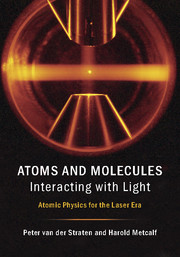Book contents
- Frontmatter
- Contents
- Preface
- Part I Atom–light interaction
- Part II Internal structure
- 7 The hydrogen atom
- 8 Fine structure
- 9 Effects of the nucleus
- 10 The alkali-metal atoms
- 11 Atoms in magnetic fields
- 12 Atoms in electric fields
- 13 Rydberg atoms
- 14 The helium atom
- 15 The periodic system of the elements
- 16 Molecules
- 17 Binding in the hydrogen molecule
- 18 Ultra-cold chemistry
- Part III Applications
- Part IV Appendix
- References
- Index
13 - Rydberg atoms
from Part II - Internal structure
Published online by Cambridge University Press: 05 February 2016
- Frontmatter
- Contents
- Preface
- Part I Atom–light interaction
- Part II Internal structure
- 7 The hydrogen atom
- 8 Fine structure
- 9 Effects of the nucleus
- 10 The alkali-metal atoms
- 11 Atoms in magnetic fields
- 12 Atoms in electric fields
- 13 Rydberg atoms
- 14 The helium atom
- 15 The periodic system of the elements
- 16 Molecules
- 17 Binding in the hydrogen molecule
- 18 Ultra-cold chemistry
- Part III Applications
- Part IV Appendix
- References
- Index
Summary
Introduction
Series of atomic spectral lines had been studied by emission from excited vapors even before Balmer described the regularity of the visible lines of hydrogen in 1884. However, direct excitation had been restricted to the few lowest-lying levels, particularly those accessible by electric dipole transitions from the ground state using classical light sources. The advent of tunable lasers in the 1970s changed such spectroscopic limitations enormonsly, allowing excitation to a very much larger number of states. Atoms in highly excited states, typically with principal quantum numbers n ≥ 10, are called Rydberg atoms. They are oversize, fragile states of significant intrinsic interest. They are very rare in nature because of their size and fragility, but they are found in interstellar space (H I regions). One of the best sources for comprehensive descriptions of Rydberg atoms and references to the literature describing their exploration is Ref. [120]. It describes their characteristic properties and behavior both classically and quantum mechanically, and especially their strongly enhanced interactions with external fields.
The first thing to note is that Rydberg atoms are usually characterized by a single, highly excited electron while all the other electrons remain in their original states. Thus their properties are very nearly classical, and the atoms are much closer to the ideal hydrogen-like model of Chap. 7, along with appropriate quantum defects (see Chap. 10). The spectroscopy of such states is especially interesting because the active electron is much less perturbed by the other electrons in the atom than when it is in lower states. Moreover, there are some special circumstances in which the energy of a Rydberg state is degenerate with an atomic state having two electrons excited to lower levels, and such configurations yield further new information.
Second, Rydberg atoms do not usually decay back to the ground state by emission of characteristic radiation, so their study is mediated by other techniques that reveal new and interesting properties. Such properties arise because Rydberg atoms have a huge dipole moment and very low binding energy resulting from the large average distance between the excited electron and the nucleus-plus-core of the rest of the atom with net charge e.
Third, transitions between Rydberg states are quite different from those connecting to the ground state for at least three reasons.
- Type
- Chapter
- Information
- Atoms and Molecules Interacting with LightAtomic Physics for the Laser Era, pp. 208 - 226Publisher: Cambridge University PressPrint publication year: 2016



